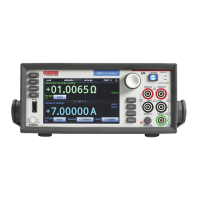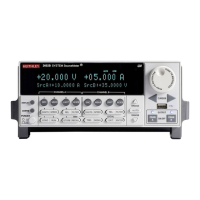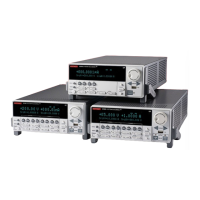Quick Results Guide 41
Output off-time — As shown in Figure 10, the output off-time consists of a minimum over-
head (2.9msec), the time it takes to measure the reference and zero, and the user-set pulse delay
(PD). For example, if the measure speed is set to 0.1 PLC, it will take 3.334msec to measure
the reference and zero (2 x 1.667msec). With pulse delay set to zero, the minimum pulse off-
time would be 6.234msec.
The output off-time can be reduced by disabling auto-zero. With auto zero disabled, the ref-
erence and zero are not measured, and the overhead time is reduced to 1.4msec (minimum).
With auto zero disabled, zero drift will eventually corrupt accuracy.
For remote operation, all measurements can be disabled. This reduces off-time overhead to
1.1msec (minimum).
Pulse duty cycle
Duty cycle, the percentage of time during the pulse period that the output is on, is calculated
as follows:
Duty cycle = Pulse width / (Pulse width + Off-time)
For example, if the pulse width is 1msec and the off-time is 9msec, duty cycle is calculated
as follows:
Duty Cycle = 1msec / (1msec + 9msec)
= 1msec / 10msec
= 0.10 (10%)
10A range limitations
Pulse width
The maximum pulse width for the 10A range (source or measure) is 2.5msec. If the setting
is >2.5msec, the SourceMeter will limit the pulse width to 2.5msec.
Charge energy consumption
Energy for pulses are provided by an internal bank of capacitors. Each pulse consumes
energy from the capacitors. The following pulse will not occur until the capacitors have had
enough time to sufficiently recharge.
Charge energy consumption by a pulse depends on the pulse current and pulse width. A long
high current pulse consumes more energy than a short low current pulse. On all but the 10A
range (source or measure), charge energy consumption is low enough to allow the capacitors
sufficient time to recharge between pulses. The result is consistent pulse output.
On the 10A range (source or measure), the configured pulse period will be consistent as long
as the pulse duty cycle is 8% or less. Above 8%, the capacitors will not be able to recharge
sufficiently before the next pulse is due. As a result, the pulse period becomes longer and
inconsistent.
